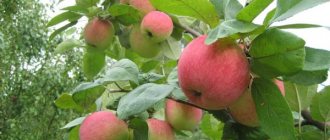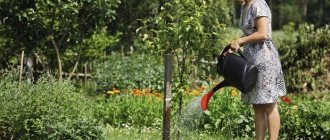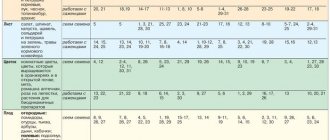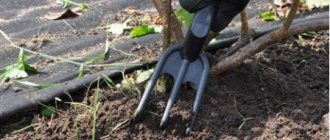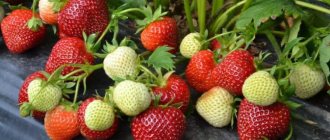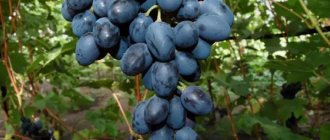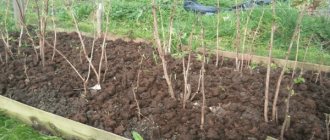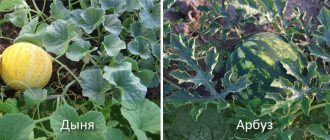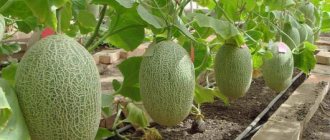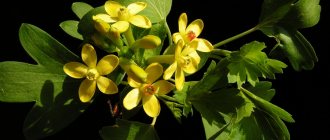Every gardener purchases and plants fruit trees with one goal - to get a decent harvest. A person does not always have sufficient information on how to care for apple tree seedlings in the first year after planting. Buying a high-yielding variety is only half the battle . Young fruit trees require not only timely polya and fertilizing, but also pruning. Giving the initial shape contributes to the further formation of the crown, which makes it convenient during harvesting.
There are recommendations for proper pruning of young seedlings that will help shape the crown and avoid mistakes.
Irrigation and watering
Newly planted or transplanted apple trees, in addition to watering 3 buckets at planting, are watered three times. The apple trees are watered for the first time half a month after planting, the second time after a month, and the third time at the time of leaf fall. The volume depends on the weather. Often this is 4-6 buckets per tree.
When caring for a young apple tree, watering is carried out taking into account the occasional rainfall and soil composition.
Timing of watering:
- the first - a couple of days before flowering;
- the second - at the moment of the fall of the excess ovary of the apple trees;
- the third - at the moment of pouring apples;
- and the last one - in September or after the leaves fall on the apple trees.
The irrigation rate for soils with average mechanical composition is 50-60 liters per apple tree, poured out in one watering. For clay soils and chernozems, 15% less water is needed, and for sandy loams and drained peatlands, 20% more of the indicated volume.
If the climate is hot and the air is dry, then water it more often: about twice, or even three times a month.
Important! The prevailing opinion on the Internet and in paper publications about burns of apple tree leaves from sprinkling irrigation is a manifestation of amateurism and does not contain even 1% of the truth. On the contrary, if you don’t water the apple tree, it will be worse than if you water it in the heat. It’s just that the water sprinkled in the crown by sprinklers will evaporate by 45% without ever getting into the root layer.
Formative pruning
Let's take a closer look at the inclination of the branches and the laying of fruit buds on them (Fig. 1). The more the branch tends to a horizontal position, the more fruit buds are laid on it. To bring the branches into a horizontal position, drive a stake next to each of them and tie the branches to it. However, I prefer another method: pruning to the outer bud (Fig. 2). The bud that wakes up after such pruning independently produces a shoot, bent to a horizontal position, on which fruit buds are quickly formed. Already in the fall you can determine whether your tree will bear fruit. If ringlets, spears, fruit twigs or fruit shoots appear on an apple or pear tree, on which fruit buds have formed (see photo), then the tree will bloom in the spring.
The pattern here is this: if there is strong growth of a young fruit tree, then, as a rule, fruit buds are not laid. To accelerate fruiting, it is necessary to weaken growth, that is, to redistribute the nutrients reaching the tree. This task can be accomplished using formative pruning and bending of branches.
Fertilizers and fertilizers
Fertilizers allow the apple tree to accumulate a large vegetative mass, which in the future will allow it to grow many tasty fruits. To do this, in the first 2 years, fertilizing is done in early spring.
The first fertilizing is done with mullein infusion, and in May and June one foliar fertilizing is done with a complex fertilizer with microelements (“Zdraven-Turbo”, “Agrovita for fruit trees”, “Alliance for fruit trees”).
Watch the video about cow manure fertilizer:
To root-feed apple trees with nitrogen in the spring, you need to pour a bucket of compost or humus into the tree trunk circle and level it.
In the following years, before the apple trees begin to bear fruit, in addition to spring fertilizing with humus with simultaneous mulching of the trunk circle (12-18 kg per tree), in the fall they fertilize with phosphorus-potassium mineral salts, for digging or hoeing:
- For southern gardens - potassium sulfate 25-35g, double superphosphate 25-35g; ashes from a fire or wood ash 150 grams;
- For non-chernozem regions - double superphosphate 35-45g, potassium sulfate 35-50 grams, ash or ash 250 grams.
TIP: Do not overfeed trees with fertilizers, especially nitrogen. This has a bad effect on the overwintering of apple trees and the keeping quality of apples. It would be better to supplement the feeding of the subcortex “by leaf” with complex fertilizer (as indicated above) or the missing element.
It is also customary to feed apple trees that have just begun to bear fruit with urea, and in years with poor flowering this can be done later.
To do this, dissolve 35 grams of urea in 10 liters of water and treat the tree with a sprayer.
The first treatment is as soon as the flower petals of the apple trees fall off, the second is a month later, and the third is when the fruits are filling. The last time the dose can be increased to 55 grams if the weather is cool and the summer is damp.
Features of summer care
In the summer, the number of activities related to caring for apple trees is significantly reduced. Nevertheless, the remaining procedures are quite important. These include watering, especially on dry days, as well as eliminating excess ovaries.
Watering
Young trees that have not yet had time to take root to the required depth need timely moisture most of all. Wilted leaves will indicate that they urgently need watering. For humidification, use water with a temperature of 18 to 25 degrees. Moisture should penetrate to the level of the root system; for trees aged 1 to 2 years it is about 80 cm.
When performing this activity, it is recommended to be guided by the following standards:
- For young specimens (1–2 years) – once every 2 weeks in the amount of 4–5 buckets. In case of heavy rainfall, you should refrain from additional watering, otherwise excess moisture will cause rotting of the root system.
- For mature trees - from 70 to 100 liters per 1 m2 of trunk circle.
On too hot days, watering is carried out in the late evening, since drops lingering on the surface of the trunk in combination with the sun's rays can lead to burns of the bark.
Young apple trees are moistened in holes made around the trunk, adults - in furrows dug to a depth of ½ meter. In order to ensure additional air flow to the root system, punctures are made in the soil. Their distance from each other is 60 cm, and their depth is 40 cm.
Removing excess ovaries
A large number of ovaries negatively affects the quality of the future harvest: the fruits are small in size and lack taste.
To prevent this problem from occurring, excess ovaries are removed. This procedure is especially important for young crops. Lack of control over the amount of harvest leads to the fact that the branches cannot hold a large number of fruits and break off. In addition, the tree itself spends too much energy, which it needs in the future for a successful winter.
Excess fruits are removed after their final formation, at the moment when they begin to gain juice. During the work, a fruit located in the center, usually having an irregular shape, is removed from each bunch. The bundles are also examined for the presence of various defects, and if they are detected, such ovaries are also removed.
If the distance between the set fruits is less than 10 cm, then whole bunches are removed.
Adding additional fertilizing
At the beginning of summer, winter varieties of apple trees are fed with mineral phosphorus compounds, which have a positive effect on the volume and taste of the future harvest. Fertilizers are applied before the fruits are formed, otherwise, once saturated with these elements, they will become unfit for consumption.
Mulching and sodding
Mulching apple trees grown using the “black fallow” or steam-green manure system:
- Significantly smoothes out temperature fluctuations during hot periods in the layer inhabited by suction roots;
- Promotes the accumulation of vermicompost ;
- And the reproduction and prosperity of beneficial soil biota;
- Allows less water to evaporate;
- Do not form a dense crust on the soil after watering or rain.
Apple trees are mulched with rotted manure, garden compost, mass after breeding earthworms, former mushroom blocks, seed husks, flax tows, and lowland peat.
IMPORTANT! The use of chaff, sawdust and shavings, straw and straw cuttings, high-moor peat, bark from stripping coniferous trunks or spruce branches is strictly prohibited!
Where apple trees grow, you can sow leaf mustard, oilseed radish, phacelia, and peas. After they grow 25 cm, the plants are mowed and left in the garden; this is also a good type of mulch.
Sodding is sowing in the rows of the garden such a mixture of grasses that will give a perennial green carpet, mow it twice a season, and the entire mowed mass is left in the area of tree trunk circles.
The most suitable composition for most of the Russian Federation is perennial ryegrass 25%, sheep fescue 22%, running fescue 28%, meadow bluegrass 25%.
But this mixture is for southern gardens: red fescue 40%, meadow bluegrass 35%, perennial ryegrass 25%. But such sowing of herbs is permissible in the 9th year following the planting of apple tree seedlings.
How to choose cherry seedlings
To get a good harvest of cherries, you need to plant several different varieties of this plant nearby. It is better, again, to choose annual plants, because... They are cheaper than two-year-olds and take root faster. When purchasing, be guided by the following parameters of seedlings: height - up to 1 m, root length - 20-30 cm, shoot length - up to 20 cm.
- How to plant cherries - step-by-step instructions for beginners
Spring is the best time to plant cherries. We'll tell you how to do it correctly.
To ensure that fruit tree seedlings survive until planting time, monitor the moisture content of the roots. Moisten the exposed roots and wrap them in cloth or place them in a bag. Wrap the trunk and branches with paper. It is advisable to secure the seedling so that it does not get damaged during transportation.
Before you go shopping for seedlings, make a clear planting plan and a list of trees you want to purchase. Do not fall for the bait of sellers who want to sell substandard plants. And try to give maximum attention to young apple trees, pears and plums so that they take root faster and please you with a generous harvest.
Processing and whitewashing of trunks
In all types of young apple orchards, not only the trunks are whitened, but also the branches that form the base of the tree.
The most suitable period for whitewashing will be from February 21 to March 31 . And the further south the garden is located, the earlier it is whitewashed. This will protect the young, rough bark of apple trees from “sunburn” and from frost damage caused by a sharp change in temperature.
For the whitewashing itself, you can use carbide, quicklime and fluff lime.
VERY IMPORTANT! Under no circumstances use bleach and compositions ready for work in damp areas!!! This is dangerous for apple trees!
Whitewash recipe: In 8 liters of water poured into a 10 liter plastic bucket, dissolve 2 kg of fluff, 1 kg of fatty clay, 1 glass of skim milk, 10 grams of wood glue or 30 grams of office glue, or one cake of fresh mullein.
Having prepared whitewash without glue, you will need to whitewash the entire garden after the first serious rain!
In the video, watch the expert’s opinion - why whitewashing of apple trees is necessary:
Late whitewashing of apple trees before the holidays in May will only decorate the garden, without really helping the apple trees. As well as whitewashing very old tree bark that is older than 20 years.
They whitewash with poplar , trying to coat everything thoroughly. If there are a large number of apple trees, whitewashing is mechanized.
If for some reason whitewashing is impossible, then tying the branches and trunks of apple trees with old agrofibre, matting, corn sheaves (corn shoots left in the field for the winter) or spruce branches will also help the apple trees “not get burned” in the sun.
Read more about whitewashing apple tree trunks here.
How to choose plum seedlings
berryandmore.ru
Plum trees will decorate your garden, but choose your seedlings carefully. Give preference to annual specimens with 2-3 shoots. Also keep in mind that all types and varieties of plums, except domestic ones, need pollinators, so purchase several varieties of seedlings at once.
- 13 important questions about planting and growing plums
Spring is just around the corner, which means new plantings. How to properly plant and care for a plum tree in order to reap the first harvest in a few years?
Treatment against diseases and pests
Chemical and biological protection against diseases and various harmful insects is one of the three important components in the question of how to care for a young apple tree.
Chemical protection of the garden should be carried out only as a destructive measure and in no case should it be used “for the sake of prevention.”
Because “chemistry” is equally dangerous for both harmful and beneficial insects, but the harmful ones, having become accustomed to the poison, multiply to incredible volumes, while the beneficial insects recover much more slowly.
Annual protection plan
Time until leaves bloom:
- Collecting and burning dry apples from branches;
- Treatment of bark with a solution of washing soda in case of an outbreak of bark beetles or treatment of twigs and branches with a solution of urea (25%) against fungal spores.
When young leaves appear:
- To prevent scab and rot, apple trees are treated with Bordeaux or HOM;
- When weevils fly, they are shaken off the branches onto bedding polyethylene in the evening or at dawn, followed by their extermination.
Flower appearance period:
- When affected by the flower beetle, more than half of the examined apple tree flowers are treated with Decis and Aktara according to the instructions;
- Diseases are treated either by using SCOR (according to instructions) or by using Bordeaux mixture when spraying apple trees;
- Ticks are destroyed with the drug “Antiklesch” or “Aktelik”;
- Gnawing and sucking are destroyed by the drugs “Dendrobacillin”, “Akarin (Agravertin)”, “Entobacterin” - these are safer drugs.
- But if the outbreak of harmful insects is large, then the insecticides Imidacloprid (200 mg-600 mg), Thiamethoxam (200 mg) are used; Chlorantraniliprole (100 mg). But carefully and only after the apple trees have bloomed! The solution is prepared strictly according to the instructions, using 2 liters per apple tree.
After flowering:
hunting belts on the trunks of apple trees . In the south they are inspected every 8 days, and in the northern regions once a month. If there is a cluster of pests, they are burned. 15 days after flowering.
Hunting belts.
In damp summers, treat apple trees with Fitosporin and Alirin-B, or Gamair and Glyokladin, but if the disease progresses, then use Quadris, Maxim and Discor.
A month after flowering.
If necessary, spray the garden against codling moth caterpillars, moths with Alpha-cypermethrin and Pirinex, but strictly according to the instructions!
18 days after the previous treatment.
If necessary, apple trees are sprayed a second time against codling moths, leaf rollers, itches, aphids and rots.
Repeat after 17 days, only when the third generation of the moth appears in the garden, and do not treat without its strong flight.
Early autumn time period before frost appears.
Treatment of the garden from wintering diseases and pests is whitewashing with copper sulfate, treatment with urea and removal of rotten carrion.
Types and varieties of fruit trees
When you have clearly decided on the planting location, it’s time to start choosing trees that will decorate your site and produce a harvest. The list of them is quite extensive. In the garden you can grow not only the usual apple trees, pears, plums and cherries, but also apricots, cherry plums, peaches, and cherries. But do not forget about the frost resistance of plants, since not all of them can successfully survive the winter in the middle zone. Since you will be planting your first garden, it makes sense to limit yourself to more popular and unpretentious crops. And only then, having gained experience, you can buy something more exotic.
It is also important to take into account the pollination of plants. You should not buy, for example, just one apple tree seedling. It is better to choose 2-3 specimens so that they can pollinate each other. If the plant is self-pollinating, such planting will increase the yield.
Modern seedlings are grafted, i.e. consist of a rootstock and a scion. Rootstocks can vary in height. To make it easier to care for your garden, give preference to seedlings on medium-sized, low-growing and dwarf rootstocks.
Pruning branches of apple trees by season:
in spring
Young apple trees need shaping and pruning in the spring. Shoots that thicken the crown are cut off by 2/3, weak ones and those killed by frost are cut out completely, as are broken ones. Competitors, tops and growths are also cut out.
If they are more than 56 cm, then by half, if less, then by 1/3. In addition, intersecting branches and shoots with traces of disease are removed.
In spring, this is done either before the leaves unfold or before flowering begins.
Watch the video of the formation of apple tree seedlings:
in autumn
Apple trees are pruned at the end of leaf fall . And this type of pruning of young apple trees consists of slightly shortening the new shoots that have grown over the summer. The trees undergo severe pruning - clearing, cutting the branches by a third of their length if the trees have not been pruned at all before.
If annual growth is weak, ½ of the shoots are cut off. If the growth is weak (less than 30 cm), then you should not remove large branches, this will weaken the tree even more.
In the fall, remove all dry, too weak, broken shoots growing in the middle and shoots extending at an angle of 25 to 40 degrees from the trunk of the apple tree. Read more about autumn pruning of apple trees here.
IMPORTANT! A day with fogs and any type of precipitation is not suitable for pruning apple trees!
Annual apple tree seedlings
An annual seedling is usually not branched, so when planting, only the central rod is shortened at a distance of 1 m from the ground.
A cut of the central conductor is made on the bud opposite to the graft.
This procedure leads to the appearance of side shoots, after which the crown is formed.
- Sometimes an annual seedling goes on sale already branched, in which case it is necessary to remove all existing side shoots at a distance of up to 70 cm .
- Next, shoots located above 70 cm . If the branches form too sharp an angle with the trunk, they are removed.
- Shoots located at right angles or close to it are shortened, leaving 3 to 5 buds . The presence of horizontal branches indicates that the tree will begin to bear fruit earlier than its counterparts, whose shoots are located at an acute angle.
Digging and tillage
Digging or hoeing in the garden is done only when the soil is completely ready (“ripe”). This is prohibited when the earth “smears” the shovel (when digging, the earth does not loosen, but sticks to the tool). The parched soil is dusty.
, humus is scattered under the trees as early as possible
When digging up soil in the garden in the autumn, the depth of cultivation should be as small as possible so as not to damage the roots of apple trees.
In the near-trunk areas, the soil is cultivated to a depth of 6-8 cm near the trunk and 11-14 cm at the end of the near-trunk zone; between rows it can be loosened to a depth of a quarter meter.
A shovel, preferably an “American” one, stands with its edge to the trunk when digging, and loosening proceeds in a circle, like a snail, with increasing digging depth, so as not to damage the main roots.
Digging the soil around the apple tree.
ADVICE: During the winter, it is better not to crush the soil when digging in the garden , but to keep it lumpy, with a hilly surface; this will supply the soil with moisture, and the overwintering stages of pests will die over the winter. But in areas with high wind erosion, they dig up once every 5 years and only in the spring! The rest of the time they dig with forged pitchforks, and in strong winds they dig with them, only loosening the soil layer without turning it over.
Loosening the soil in the tree trunk circle
To enrich the soil with oxygen, it is useful to carry out shallow loosening of the soil. It is enough to immerse the rake by 5-7 cm, no more.
Mulching and sodding
More and more gardeners are practicing “natural” cultivation of apple trees, when there is no bare soil in the garden. The space under the trees is sown with grasses (clover, phacelia, alfalfa, bluegrass, bentgrass) or covered with straw or mown hay.
Worms actively reproduce under the mulch and loosen the soil. The roots of the tree are well protected from the summer heat.
Caring for young apple trees by season:
in spring
Caring for young apple trees in spring is:
- Pruning after winter;
- Feeding and mulching of tree trunk circles;
- Protection of apple trees from frost;
- Protection from diseases and harmful insects.
These are all activities for spring garden care.
In summer
Caring for young apple trees in the summer mainly means fighting emerging diseases and caterpillars on apple trees, mites and aphids.
When it’s hot, the garden is watered, and when there are obvious nutritional shortages, the trees are fed. They pull out weeds in the aisles and near-trunk circles of young apple trees. It would be good to loosen the soil after surface watering or rains, otherwise the apple trees will have difficulty with the soil crust.
in autumn
Caring for young apple trees in the fall consists of special whitewashing of the upper part of the tree, while the bottom is wrapped with felt, spruce branches or geotextiles to prevent the gnawing of hares and mice.
When wondering how to care for a young apple tree in the first year of planting, know that it is quite simple. The apple tree does not need feeding in the fall; it has enough organic matter in the mulch and minerals in the planting hole.
Apple trees over 4 years old are fed as follows: 25 grams of potassium and 35 grams of phosphorus per tree.
Spring care principles
With the onset of spring, the complex of measures for caring for apple trees is quite extensive, since at this time all living organisms, including pests, wake up after winter hibernation. Therefore, it is necessary to have time to provide the garden with reliable protection. Otherwise, damaged trees will not produce a good harvest and will become a haven for harmful insects.
Necessary equipment
To carry out all procedures aimed at maintaining the health of apple trees, you need to have the following gardening tools available:
- pruner;
- sprayer (preferably backpack);
- rake;
- gardening scissors;
- pitchfork;
- saw;
- watering can;
- PPE: gloves, suit, mask;
- hoses;
- shovel.
Removing winter shelter
Since the onset of thaw in each region occurs at different times, it is impossible to set an exact date for releasing apple trees from winter shelter. When performing such work, it is necessary to focus on the air temperature indicator. So, for example, insulation is not removed at low temperatures. Ideal conditions for the procedure are the range from +12 to +16 °C during the daytime. It is advisable to remove the insulation in parts, for several days in a row. This solution will allow the trees to painlessly adapt to the new environment.
Natural covering material that is fully breathable can be left until high temperatures have completely stabilized.
Inspection and repair of damage
After winter, gardeners carefully examine the surface of the trunk to detect various damage caused by severe frosts or pests.
The affected areas are treated with garden resin, and all identified cracks are covered with special care to prevent their spread. Around each apple tree, fallen branches, last year's leaves and rotten fruits are removed. All this represents an ideal environment for the proliferation of harmful microorganisms that can infect tree bark in a short time.
If a hollow is discovered, it is necessary to treat the damaged area and eliminate the defect using some special material.
Whitewash rules
All apple trees under the age of 15 years require spring whitewashing, which protects the trunk from the negative effects of ultraviolet rays. The bark of more mature specimens is fully formed and resistant to burns. The optimal time for such an event is the end of February or the beginning of March, when the sun is not yet active enough to cause much harm to fruit crops.
Before starting the procedure, you need to remove from the trunk the organisms that have accumulated over the winter: moss and lichen, the surface of which is an ideal environment for parasites. It is recommended to use special garden paint based on acrylic for whitewashing. This material has a number of advantages: it is resistant to environmental changes, does not peel off at low temperatures and is not washed off even by heavy rainfall.
The paint is usually applied from the base of the apple tree and rises to the skeletal branches of the first order, covering them as well.
For whitewashing, it is permissible to use chalk, copper sulfate or lime. However, it must be remembered that it is not recommended to paint young trees with lime paint, since this composition can seriously damage the trunk.
Trimming
Timely pruning plays an important role in caring for apple trees.
Not only adults, but also young trees need this procedure. By removing some of the branches, the correct crown is formed, as well as its cleaning and rejuvenation. Pruning removes young shoots that block the sun from reaching previously formed branches. In addition, gardeners get rid of shoots that point sharply upward. In seedlings, this procedure helps strengthen the skeletal branches. The operation must be performed so that there is a distance of 40 to 70 cm between the skeleton-forming branches. When processing old apple trees, special attention is paid to getting rid of dead wood.
It is permissible to prune at a temperature not lower than −7 °C, usually this happens in March.
The event is prohibited during the period when a green cone appears on the tree, in the last days of April or at the beginning of May. Fruit crops with a height of 4.5 to 5 m are shortened. All operations are performed using a hacksaw and hand pruners.
Construction of supports
Often the harvest ripens so much that the branches of the apple trees, unable to withstand the weight, crack and break. Ignoring this problem can lead to the death of the entire tree. In this case, you will need supports, which come in two types:
- external, placed directly under the branches;
- internal, tied to the branches inside the tree using wire.
Sometimes, despite the presence of supports, a branch may break. If this happens to a young branch, then it needs to be cut down into a ring, and then the cut area must be cleaned and painted. As for the old, fruit-bearing branch, it must be fixed on the trunk, otherwise its loss will lead to disruption of the fruiting of all other branches.
Protection from harmful insects and diseases
It is impossible to grow a healthy apple tree without timely spraying with preparations that protect the crop from pests and various diseases. With the onset of spring, harmful insects wake up, at this time it is necessary to install special trap belts around the trunk. For this case, it is recommended to use an adhesive belt: it fits perfectly to the trunk, preventing pests from passing under it.
1st treatment The first spraying of the apple orchard is carried out with Bordeaux mixture or copper sulfate on bare branches, the second - after the formation of a green cone, at which time the temperature has already reached 15 ° C. The following preparations are used to treat trees:
- "Decis";
- "Tanrek";
- "Spark";
- "Intavir";
- "Fufanon."
The composition, prepared from two drugs - “Aktelik” and “Chorus”, effectively gets rid of pests and at the same time prevents the occurrence of diseases.
3 treatment
For the third treatment, experts recommend the use of bacterial preparations characterized by minimal toxicity, for example:
- "Fitoverm";
- "Lepidocide";
- "Bitoxibacillin."
Spraying is carried out in calm and not rainy weather. If this condition is met, the potent components of the drugs begin to kill pests 4–5 hours after the procedure.
2 treatment
After the end of the flowering period, gardeners perform a second spraying (on the rose bud). During this period, the tree is at risk of repeated attack by pests, as well as infection by mature fungal spores.
4 treatment The fourth treatment is carried out on the ovaries formed after the flowering of apple trees. For this purpose, mix two drugs “Skor” and “Aktar” in a ratio of 1: 1, taking 2 g of each. Afterwards, both components are dissolved in 10 liters of water and poured into the sprayer.
Top dressing
The first fertilizing is recommended in April; the operation is performed by adding nutrients to the soil to a depth of 20–25 cm. In the process, small depressions are formed into which granular fertilizers are poured. This method provides apple trees with all the necessary substances for 2–3 years.
Dry fertilizers are applied to moist soil, so if necessary, water first.
Fertilizers used for feeding at the end of May should not contain nitrogen. At this time, gardeners are biased towards phosphorus and potassium options. This solution stimulates the formation of flowers, thereby increasing productivity.
Watering
Proper care of an apple orchard involves timely watering. In a warm and dry spring, trees need a sufficient amount of moisture, especially for young specimens. In this case, the recommended watering frequency is 4–5 days.
To preserve moisture, the tree trunk circle is sprinkled with a thin layer of mulch: peat or straw.
It is undesirable to use sawdust as mulch because of its ability to increase soil acidity.
Tips for pest control
Here is a list of important tips and reminders for apple tree growers:
- Before using each drug for the first time, you must try it on one of the branches of the apple tree. If after 48 hours the condition of the leaves has not deteriorated, then it can be consumed.
- For greater effectiveness of “chemistry” in the war for the harvest, you need to alternate the active ingredients in the preparations in the garden.
- Always read the manual and study the label and information about the drug online before using it.
- Spray the garden taking all safety precautions.
- Infusion and decoction of tobacco is toxic to humans!
- Treatment during flowering is dangerous for apple trees !
Caring for young apple trees brings excellent results.
Common mistakes and advice from gardeners
The main mistake of novice gardeners is the belief that the tree will produce a harvest even without care. A young seedling is capable of bearing fruit for several years without human help, but the harvest will become smaller from year to year.
It is impossible to know everything about apple trees, but these points must be remembered well:
- in the first year after planting, seedlings should be watered frequently;
- feed the trees at the beginning of summer, during the growth of the ovary;
- in the fall, prune and treat for fungi;
- Do not leave plant debris in the garden.
Proper care of an orchard in open ground will allow you to annually obtain a harvest of delicious apples.
Spraying with urea solution
Of the foliar feedings, the most accessible and widespread is spraying trees after flowering with a 0.5% urea solution. This event is usually combined with treating trees with Bordeaux mixture.
In late autumn, spraying plants with a more concentrated (5%) urea solution is an effective way to combat scab. Fruit and berry crops growing on moist and peaty soils respond especially well to spraying with a 0.02 - 0.025% solution of copper sulfate.
Compatibility with neighboring plants
If the site is not intended exclusively for fruit trees, then the free area can be used for planting vegetables. While apple trees are young, their crowns do not provide abundant shade. Therefore, you can plant vegetables in close proximity to trees.
According to experts, the following vegetable crops are best suited for planting next to apple trees:
- cabbage;
- radish;
- legumes (peas, beans, beans);
- low-growing tomatoes.
This proximity has a beneficial effect on the growth and development of apple trees. After all, when watering and fertilizing vegetables, the root system of trees also receives moisture and nutrition.
Crops such as sunflowers and corn should not be planted next to apple trees. They dry out, deplete the soil and shade young tree seedlings.
Apple harvest. The illustration for the article is used under the standard license ©ofazende.ru
Lack of moisture in fruit plants
Fruit plantings often experience a lack of moisture. Trees need watering especially after the end of the flowering period, 25 - 30 days before harvesting and immediately after harvesting the fruits. In addition, one late-autumn moisture-recharging irrigation is carried out.
In collective gardens and personal plots, water is directed into ditches (25–30 cm wide, 15–20 cm deep) dug around trees in 2–3 rows (rings). The ditches are filled with water repeatedly to saturate the soil to a depth of 50–60 cm. The next day, as soon as the ditches have dried slightly, they are leveled with earth.
Applying fertilizer as the tree's roots grow
As trees grow, the root system spreads further and further. Every year, the roots grow approximately 35 - 50 cm. Horizontal roots are located at a depth of 20 - 45 cm and extend from the trunk much further (1.5 - 2 times) than the branches. In the 4th – 5th year after planting the garden, the diameter of the deeply cultivated zone is expanded to 3 – 3.5 m.
To do this, in the fall, organic and mineral fertilizers are applied in increased doses outside the planting hole and the soil is dug deep (34–45 cm) without bringing the clay part to the surface.
After 6–7 years, this zone will also be reclaimed by roots. By this time, the next zone, more distant from the trunk, is carefully fertilized and deeply dug, bringing the diameter of the cultivated tree trunk circle to 4.5 - 5 m. Thus, favorable conditions are created for the spread of roots in the deep layers of the soil, where in summer there is a better supply of moisture, and in winter it is 3 – 5 warmer.
In mature trees, the most active (fibrous) roots are located outside the crown; near the trunk there are large roots that conduct minerals and water to the leaves, and organic substances accumulated in the leaves to the roots.
But they themselves are not able to absorb either water or nutrients from the soil. Taking this into account, in fruit-bearing gardens organic and mineral fertilizers are applied not close to the trunk, as some amateur gardeners mistakenly do, but further away from it, where the most active roots are located.
